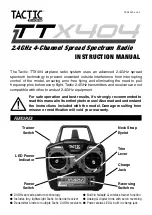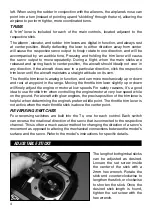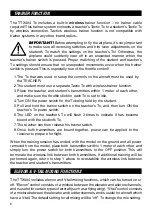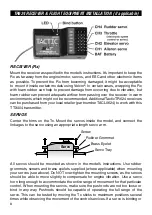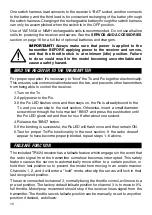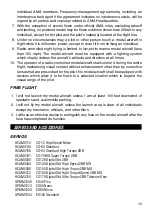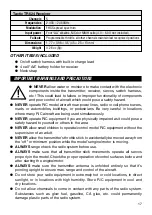
3
Tx should have adequate power for fl ight when the LED is on constantly. Anytime
the LED begins to fl ash, accompanied by the sounding of an audible tone, the Tx
battery voltage has dropped too low
and operation of the model should NOT
be attempted!
WARNING!
Never operate an R/C model with weak Tx batteries!
Reduced operational range and/or possible loss of control of the
aircraft could result. Replace weak alkaline batteries, or re-charge
NiCd or NiMH batteries before attempting a fl ight!
If during a fl ight the Tx LED starts to fl ash, accompanied by the sounding of audible
tones, it’s a warning that the Tx batteries have become weak and the aircraft should
be landed as soon as possible!
AILERON (CH1)
Controls the moveable surfaces at the end of both main wings to rotate the airplane
about the “roll” axis (an imaginary line which extends from the airplane’s nose to
the tail). Since every airplane is different, the aileron reversing switch must be set
so that moving the aileron stick to the right will cause the airplane’s right aileron to
defl ect up, thus causing the right wing to drop and the airplane will bank to the right.
Moving the aileron stick to the left will cause the airplane’s left wing to drop and the
airplane will bank to the left. This is one important method for turning the aircraft.
ELEVATOR (CH2)
Controls the moveable horizontal surfaces on the airplane’s tail to rotate the airplane
about the “pitch” axis (an imaginary line extending through the center of both main
wings, from one wing tip to the other wing tip). Position the elevator reversing switch
so that pulling the elevator stick back (towards you) will cause the elevators to
defl ect up, thus causing the nose of the airplane to rise. Pushing the elevator stick
forwards (away from you) will cause the nose of the airplane to drop. When using
the ailerons to bank the airplane’s wings, pulling the elevator stick back will help the
aircraft maintain altitude and turn the aircraft more quickly.
THROTTLE (CH3)
Controls the speed (R.P.M.) at which the engine or electric motor operates. With
the throttle reversing switch in the NOR position, pulling the throttle stick back will
cause the engine’s speed to decrease. Pushing the throttle stick forward will cause
the engine’s speed to increase.
RUDDER (CH4)
Controls the sideways movement of the airplane’s tail and will rotate the airplane
about the “yaw axis” (an imaginary line from the top of the airplane’s fuselage to
the bottom of the fuselage, located near the center-point of the fuselage). Position
the rudder reversing switch so that moving the rudder stick to the right causes the
rudder to defl ect to the right, thus causing the nose of the airplane to point to the
right. Moving the rudder stick to the left will cause the nose of the airplane to turn

